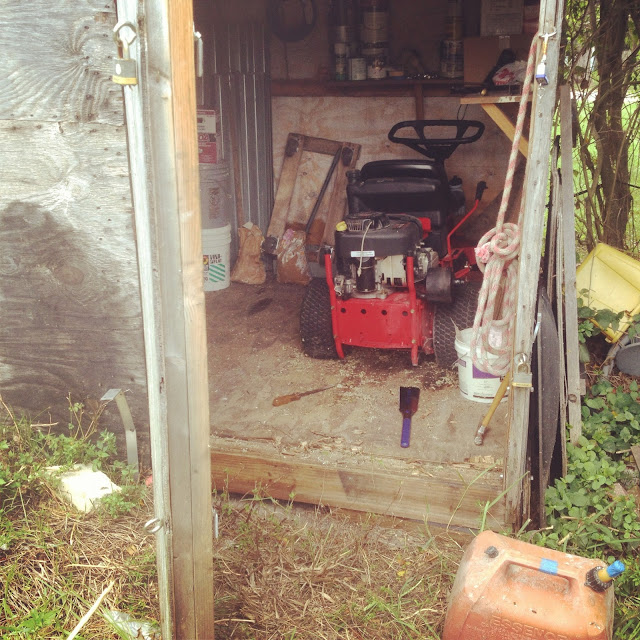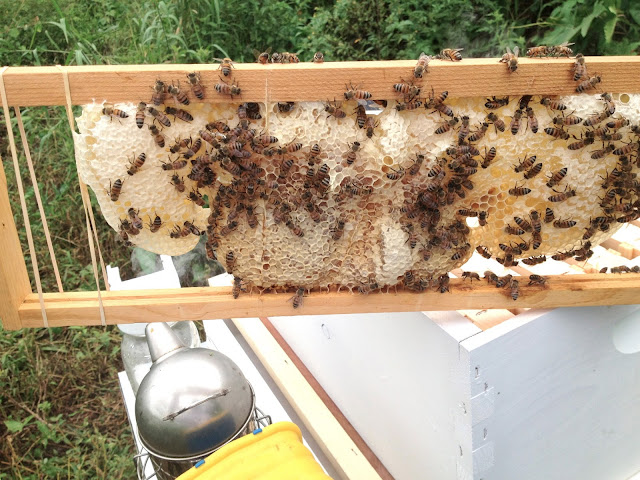So, for a while I'd been using cinder blocks as a base for my hives. Unfortunately, cinder blocks provide LOTS of surface area for ant activity. Before I knew it, the base of my cinderblocks had become causeways for fire ants. On the positive side, the ants are more interested in dead bees than honey. The ants have been doing an excellent, and very timely, job of keeping the ground free of dead bees. This in turn keeps away more serious pests, and the stray ants do get bullied away from the hive interior by guard bees. It's actually really neat to see! Without physically feeling the wind that comes off of a single bees wings, one would never guess just how powerful they are. If I had three bees on my veil to act as fans at all times, I'd never break a sweat. These girls pack some serious horsepower in those wings! When I was removing the bees from the toolshed, the floor had ended up being covered in sawdust. There'd be the occasional bee lazily flying around the shed about 2 feet off the floor. Those bees would be parting the sawdust in the same way that a boat splits the ocean to create a wake. It's not uncommon to see a guard bee chase an ant to the edge of the entrance, and then turn around to literally blow the ant off the edge with air buffets from it's wings! Crazy girls. They impress me every time I visit the hives.
That being said, it's a sad fact of beekeeping that it's not uncommon to crunch a bee or three between the outer cover (lid of the hive w/ aluminum covering) and the inner cover or sides of the hive. Ants love to get in there and clean up whoever got crunched. It's a nice service, but I do worry about them overcoming a weak hive, or setting up a nest between the top & inner cover, and going for larvae. So we need something better than cinder blocks. This calls for an actual hive stand with wooden legs!
The nice thing about wooden legs is that it's possible to sit them in cans of motor oil. Motor oil creates an impassible moat that the ants won't be able to cross. Presto! Ant free bee hives! Vegetable oil is no good by the way. It instantly absorbs moisture from the air and will spoil real quick. That in turn will just attract more pests/mold, compounding the problem.
Here's my design. It's simple, sturdy, and the horizontal beams are situated on TOP of the legs. That way, the weight bears down on the legs, and is distributed by the horizontal beams. That way the nails mainly serve to connect the boards so that there's no movement in the boards. The weight is supported by the density and integrity of the wood, rather than on the integrity of the nails. I'd bet on the nails more quickly rotting through in a 24/7 outdoor environment than this copper weather-treated wood.
I'm not naive enough to think that no one has come up with this design before, but I wasn't able to find it anywhere else. So I'm going to be willfully ignorant and bask in my own ingenuity for the time it takes to write this tutorial haha.
$7 Hive Stand Tutorial:
Materials For 2 Stands
3 - 2x4 8" Weather Treated lumber
1 - Saw (I use a Japanese style "ryoba" pull saw)
32 - Weather Treated self-starting 2 1/2" screws
1 - Electric Driver/Drill with a screw-appropriate bit
1 - Measuring Tape
1- Pencil
1 - Pair of gloves (I use soft calf hide. The wood treated lumber is construction grade and will splinter the heck of you real quick, not to mention avoiding the absorption of weathering treatment)
1 - Breathing mask (if sawing in a low-breeze area, you don't want to inhale the moist copper and chemical infused sawdust, seriously.)
1 - Bottom board of a nuc box, if on hand
Step 1)
Measure out your wood! For two of the 2x4s, you'll want to measure out two 3' pieces and two 1' pieces. The longer pieces will be the horizontal supports, and the smaller will be braces.
The third 2x4 you'll want to cut into four pieces, which are 2' each. These will be the legs.
Step 2)
Use the bottom board of a nuc box to layout the pieces. I didn't see this anywhere, but it just "worked" when I needed something to hold my long boards in place while drilling out these holes. I was a cheapskate and didn't buy self-drilling screws. Learn from my mistakes!
The long support beams fit perfectly on the sides as you can see, and the stabilizing braces also evened out nicely, with the edges approximately centered on the long support beams. You'll just have to eyeball the spacing of the braces from each other. You'll want them about 4" in from the edges. That seems to center the weigh on the legs nicely, while still having the legs close enough to the middle that the support beams won't sag in the middle over time. Also, make sure that the 2' segments settle nicely in next to the support braces, like above.
Step 3)
Screw it all together! Two screws per piece, reference the picture of the finished stand that's flipped upside down. The screws going vertically through support beam <-> braces are wide set, about an inch in from the edges. The screws going horizontal through leg <-> brace are a bit more closely set, that way they run on the inside of the vertical screws.
PRESTO! Your super amazing, ridiculously good looking hive stands are complete! How sweet is that? It took me a longer time since I was kind of generating the plans for this as I went along, but I'm sure it will go much more quickly for anyone following this. It's a lot more simple than other plans, three major steps, and costs $5 per piece of 2x4. That's pretty hard to beat! Store bought stands can run $40 EASY. These can each support two hives with telescoping covers, and can easily be lined up so that the beekeeper can walk down a pathway, with hives on both left and right, with entrances facing away from the keeper.
Not too shabby methinks.











.jpg)









































